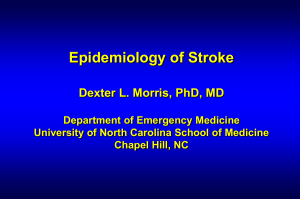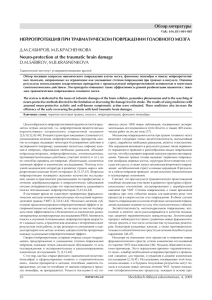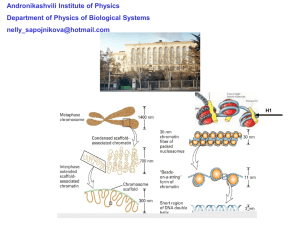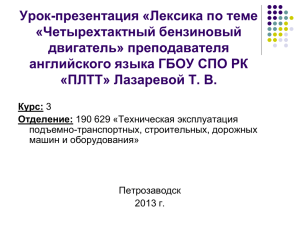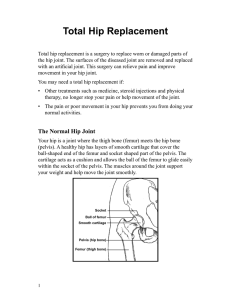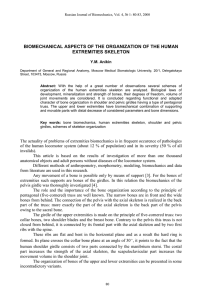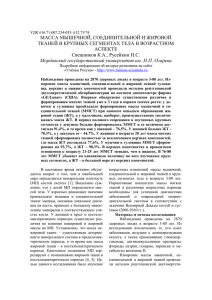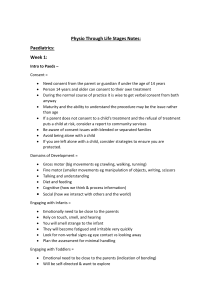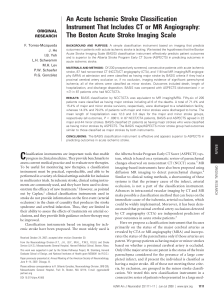БИОЭЛЕКТРИЧЕСКАЯ АКТИВНОСТЬ ГОЛОВНОГО МОЗГА И
реклама
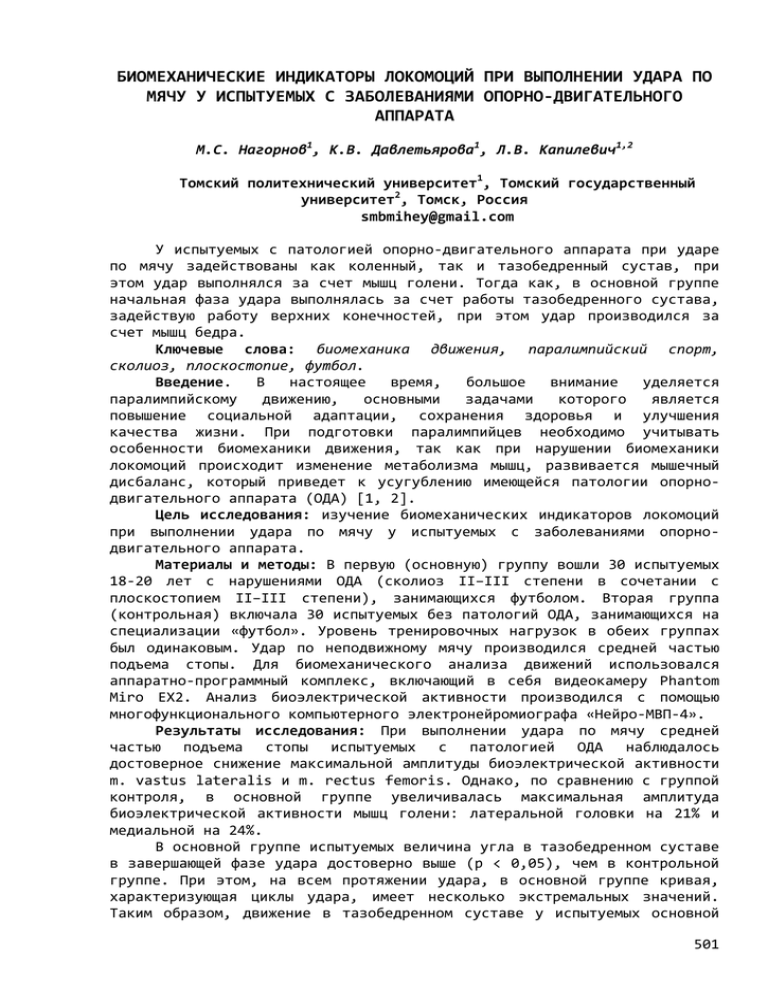
. . , 1 . . , 1 . . 1,2 , 1 , , [email protected] 2 , : , . . , , , [ , : . II–III « . . ». , - ]. : 0 0 II–III , . , , Miro Eз . Phantom « : m. vastus lateralis , m. rectus femoris. , , - - ». , : %. , , , , , . , , , . 18- 0 . , . , - % p < 0,0 , , , . 501 , , , , p . . ., 0,0 , . . . , , , . , , . . , . < , : , . . , , . ., . , . № 15-16-70005 . ., . . // , 0 , № , . -24. . ., . . // : . . . . . – .: – , 00 . – . – 628. 3. Nagornov M.S., Davlet'yarova K.V., Iljin A.A., Kapilevich L.V. Physiological features of shot technique of football players with musculoskeletal disorders // Teoriya i Praktika Fizicheskoy Kultury. 2015 - №. . - C. 8-10. . LOCOMOгION’в BIOMECHANICAL INDICATORS OF THE TEST SUBJECTS WITH LOCOMOTOR SYSTEM'S DISEASES IN MAKING A STROKE ON THE BALL M.S. Nagornov1, K.V. Davlet'yarova1, L.V. Kapilevich1,2 Tomsk Polytechnic University1, Tomsk State University2, Tomsk, Russian Federation [email protected] In the matter of the test subjects with the locomotor system s pathology as the knee and hip joints are involved in making a stroke on the ball, while the kick is taken by the leg muscles. Whereas the initial phase of healthy player s kick was due to the work of the hip joint, involved the work of the upper extremities, and the kick was made by the thigh muscles. 502 Key words: biomechanics of movement, paralympic sports, scoliosis, flatfoot, football. Introduction. Currently, great attention is paid to the Paralympic Movement, whose main objectives is to improve the social adaptation, health and life quality. When preparing Paralympic athletes features of movement s biomechanics should be considered, as in violation of the locomotion s biomechanics the muscles metabolism changes, muscle imbalances develop, that lead to the aggravation of existing diseases the locomotor system [1, 2]. Objective: studying of the locomotion s biomechanical indicators of the test subjects with scoliosis (II-III degree) and flat feet (IIIII) degree in making a stroke on the ball. Materials and methods: The first (basic) group included 30 test subjects in the age of 18-20 years with impaired locomotor (scoliosis of II-III degree, combined with flatfoot II-III degree), involved in football. The second group (control) consisted of 30 test subjects without locomotor pathologies, involved in the "football" specialization. The level of training loads in the both groups were similar. Hitting the fixed ball was made by the middle part of the instep. Hardware-software system, included a video camera Phantom Miro EX2, was used for movement s biomechanical analysis. Bioelectric activity analysis was carried out via the multifunction computer electroneuromyography "Neuro-MEP-4". Results: In making a stroke on the ball by the middle part of the instep by the test subjects with locomotor diseases there was a significant reduction in the maximum amplitude of the bioelectric activity of the m. vastus lateralis and m. rectus femoris. However, the maximum amplitude of the bioelectric activity of the leg muscles was increased in comparison with the control group: lateral head by 21% and median by 24%. In the basic group of the test subjects the hip joint angle in the final phase of the stroke was significantly higher (p <0,05), as compared with the control group. At the same time, the curve, characterizing stroke cycles, has some extreme values in the basic group. Thus, movement in the hip joint the group with locomotor diseases is in antiphase in comparison with the control group. In the study of the knee joint angle in making a stroke by the middle part of the instep, it was shown that throughout the stroke the angles in the basic group were significantly greater (p <0,05), in comparison with the control group. In the final phase of impact differences disappeared. The difference in the dynamics of the angles of the upper extremities joints was less pronounced. Changes in the shoulder joint angle in the control group were slightly greater after phase 2 and had a more gradual nature, compared with the values of the basic group. Vice versa, the elbow angles had lower values in the control than in the main group. Conclusion: In the matter of the test subjects with the locomotor system s pathology movement s mismatch of the upper and of the lower extremities was observed while making a stroke on the ball, at the same time in the first phase of the strike as the knee and hip joints were involved. Movement in the joints of the upper extremities was not 503 happening, they have been connected only in the final phase. This stroke was mainly due to the leg muscles. Whereas, in the control group the first phase of the stroke was due to the hip joint, wherein the joints of the upper extremities were involved. This stroke was mainly due to the thigh muscles. This work was supported in part by RHSF № -16-70005. References 1.Kapilevich L.V., Guzhov F.A., Bredikhina Y.P., Iljin A.A. Physiological mechanisms to ensure accuracy and coordination of movements under conditions of unstable equilibrium and moving target (the case of strikes in sports karate) // Teoriya i Praktika Fizicheskoy Kultury. - 2014 - №. . - p. 22-24/ 2.Dubrovsky V.I, Fedorov V.N. The pathological biomechanics //: Proc. environments. and higher. Proc. institutions. - M .: Publishing House VLADOS - PRESS 2003. – p.. 591 – 628. 3.Nagornov M.S., Davlet'yarova K.V., Iljin A.A., Kapilevich L.V. Physiological features of shot technique of football players with musculoskeletal disorders // Teoriya i Praktika Fizicheskoy Kultury. 2015 - №. 7. - C. 8-10. DOI:10.12737/12432 . ., . ., . ., . . . . . , [email protected] : , , , , , . . , , . , , , , . , , . [ , , , ], . , [ ], , , , . 504 , ; ,


